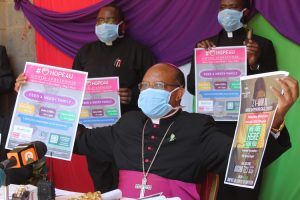
Archbishop Muheria heads the Interfaith Council that oversees the re-opening of places of worship. (courtesy photo).
As the political leaders of African nations sought to stem the tide of COVID-19 cases, many religious authorities across the continent followed suit and called on their followers to heed their governments’ directives to observe the protocols put in place.
But now, after four months of social and commercial lockdown, many African countries are seeking to alleviate the resulting economic hardships by cautiously relaxing some of these restrictions. Again following suit, Africa’s bishops are likewise issuing guidelines for multiphased reopenings of Catholic churches on the continent. A model case in point, the Kenyan bishops are seeking to reintroduce public worship with carefully drafted guidelines that also respect current civil mandates restricting public gatherings.
In March, like much of the rest of the world’s bishops, the Kenya Conference of Catholic Bishops (KCCB) banned public celebration of Mass and other religious services. In place of public worship, the Kenyan bishops had organized televised Mass from the Holy Family Basilica in the Archdiocese of Nairobi.
More recently, however, with Kenya’s President Uhuru Kenyatta announcing a phased reopening of Kenya, the KCCB issued liturgical guideline for the reopening of public worship following Kenyatta’s earlier appointment of an interfaith council. The council whose term of service will end in December 2020 is headed by Archbishop Anthony Muheria. Its 16 members are to guide the Kenyan government’s efforts toward the gradual and progressive reopening of in-person religious worship
On July 6, Kenyatta directed that places of worship begin phased reopening for public worship, but with limited attendance at a given celebration.
“In strict conformity with all the applicable guidelines and protocols, including the self-regulating guidelines developed by the Inter-Faith Council, a maximum of 100 participants will be allowed at each worship ceremony,” Kenyatta’s statement read in part. The statement also stressed those congregants who are younger than 13 or older than 58, or who have underlying health conditions, are not allowed to attend public worship services.
The bishops’ June 30 guidelines, which preceded Kenyatta’s statement by a week, were stricter than the civil guidelines in terms of the number of worshippers at any given celebration. The liturgical guidelines directed that churches were only to have a 15% capacity in the first phase of reopening public worship, while the second and third phases would allow 25% and 50% attendance, respectively.
The guidelines further set up other stringent hygiene practices that require regular sanitization of churches, pews and other equipment used during worship, while also providing sanitizers and face masks to those who can’t afford them.
The guidelines, signed by KCCB’s chairman, Archbishop Philip Anyolo, identified education as a key to fighting the pandemic and thus urged church ministers to have a “COVID-19 moment” with their parishioners to pass on messages on preventive measures.
The KCCB guidelines also called for the education of Christians on the guidelines related to the celebration of the sacraments in conformity to social-distancing rules, while limiting the number at weddings and other religious ceremonies to 100 people.
By Sr. Grace Candiru
